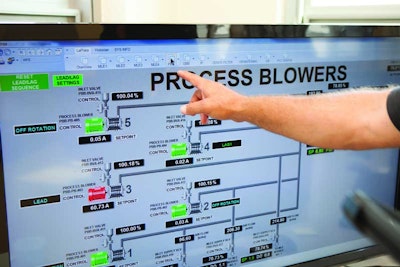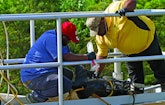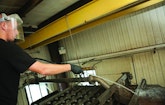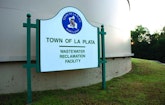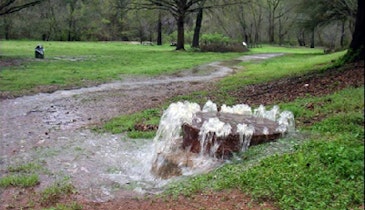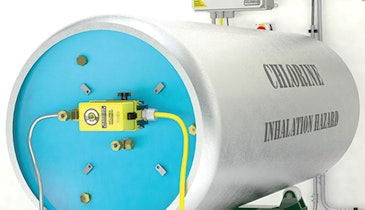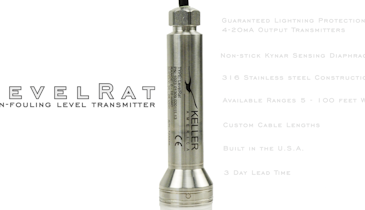
Interested in Treatment?
Get Treatment articles, news and videos right in your inbox! Sign up now.
Treatment + Get AlertsHeavy runoff caused sanitary sewer overflows in the Town of La Plata, Maryland. At the La Plata Wastewater Reclamation Facility, high influxes of clear water washed away much of the bacteria colony in the sand filters.
A 2001 U.S. EPA mandate to update the treatment plant to biological nutrient removal didn’t include what was really needed — additional equalization tanks. Frequent SSOs, which began in 1988, forced the town into a 2005 consent decree with the state Department of the Environment to reduce inflow and infiltration. Other consent orders followed. Under the Chesapeake Bay 2000 Agreement, the plant also faced compliance with enhanced nutrient removal standards by 2010.
That was a lot to ask from a municipality with under 50 employees. To coordinate its efforts, the town created a director of operations position and in January 2008 hired Robert Stahl to fill it. Stahl oversees the water, wastewater and stormwater utilities and manages the Public Works, Roads and Streets, and Parks departments.
“I’m not satisfied with being No. 2,” says Stahl. “I told everyone we would operate the best treatment plant instead of chasing our tails fixing problems.” The staff welcomed the change in culture and willingly accepted modern technology. In 2013, Stahl was named Decision-Maker of the Year by the Maryland Rural Water Association. Two years later, the organization named La Plata the Wastewater System of the Year for improving the quality and consistency of the treatment process and service to customers.
Package modules
Built in 1971 and upgraded in 2001 and 2011, La Plata’s 1.5 mgd (design) activated sludge plant sits on the side of a steep hill. Wastewater from 9,000 customers flows over an Aqua Guard filter element screen (Parkson Corp.) and into a wet well with two 2,200 gpm pumps (WILO USA) that lift influent 50 feet to two cyclone grit separators (Envirodyne Systems). Liquid then flows by gravity to a distribution box that evenly doses four identical 500,000-gallon modified Ludzack-Ettinger process bioreactors (Evoqua Water Technologies).
Each module has a clarifier in the center surrounded by treatment tanks with WILO pumps and mixers supplied by Evoqua. Influent enters a distribution box on the top of the first anoxic mixing zone on the module’s far side. A V-notch weir sends 350 gpm to the anoxic zone and excess downstream to an 85,000-gallon equalization basin.
Moving counterclockwise, influent flows through the second and third anoxic zones before entering the switch tank, which is anoxic in summer for additional denitrification and oxic in winter. It has a dozen 9-inch tapered ceramic fine-bubble diffusers (Sanitaire - a Xylem Brand) on one bar. From the switch tank, liquid enters the oxic zone with 64 fine-bubble diffusers on five evenly spaced bars. The last bar closest to the internal recycle zone has only four diffusers to reduce dissolved oxygen to almost zero.
Twenty-five percent of the liquid flowing into the recycle zone is pumped to the distilling well in the center of the clarifier. Solids swept by rakes to the center are pumped to the first anoxic zone. During wasting, pumps send solids to the digester tank between the equalization basin and the recycle zone. To remove phosphorus, pumps inject alum and polymer into the distilling well. Treated water flows to a rapid-mix tank, then to a DAVCO tertiary upflow cone clarifier (Evoqua Water Technologies).
Liquid leaving the cone filter flows through a pinch valve that keeps the launders (overflow weirs) full and prevents introduction of large amounts of oxygen to three DynaSand EcoWash sand filters (Parkson Corp.). Denitrified effluent flows off the filters to a reaeration zone, then passes two banks of TrojanUV3000 60-inch UV reactors. Disinfected effluent discharges to a tributary of Port Tobacco River.
Biosolids are aerobically digested; decant water is pumped back through the bioreactor. The thickened material is then dewatered in a 1.2-meter belt press (Alfa Laval Ashbrook Simon-Hartley) before being landfilled.
Shock loads
Over the past five years, major improvements to the collections system ended SSOs, but 2 to 3 inches of rain can still spike inflow to 4 mgd at the plant, which is designed for a four-hour surge of 3 mgd. Operators prepare for storms by feeding polymer to lower the sludge blankets in the clarifiers and prevent them from washing out. “That is our biggest concern during high flows,” says Stahl.
Another concern is sustaining a thriving bacteria colony in the sand filters. The mainly residential influent has very low solids, and the bioreactors eat all of it. Effluent from them averages a starvation diet of 1.65 mg/L nitrate. “We constantly feed methanol as a carbon source and increase the dose after high influxes to stimulate the depleted colonies,” says Stahl.
Besides dealing with natural events, operators preparing for the recent upgrade unwittingly created a problem by cleaning the three bioreactor modules, which took three months to dry. Once the tanks were back in service, the water was difficult to oxygenate. The rubber sleeves on the diffusers had dried out, and the sun’s UV rays had hardened the material. The only remedy was to replace the sleeves.
“It took two days to drain and clean a module,” says Stahl. “The third day, we lifted out the diffuser bars with a crane, removed and cleaned the diffusers, and fitted new sleeves. That restored our DO numbers.”
Good neighbors
Stahl is immensely proud of his team members and their accomplishments. Because La Plata is a small municipality, operators learn everything relevant to water and wastewater treatment. Once trained, many join larger nearby plants with higher wages. To ensure a steadfast core of operators, the town contracts with Maryland Environmental Service to operate the plant. “I don’t separate La Plata employees from MES employees,” says Stahl. “I tell them they all work for the town.”
During the $9 million upgrade in 2011, the community had an ace in the hole: Stahl’s background in construction made him confident enough to assume the responsibility of construction manager for the $9 million upgrade. Keeping the project in-house saved the town more than $500,000.
The team was responsible for more than 40 design changes that increased the plant’s efficiency and good neighbor status. In one case, the design specified a separate digester blower building with a generator, two blowers (one for redundancy), and electric service just for the fourth bioreactor.
An operator observed that the site already had a building with four Hoffman & Lamson centrifugal process blowers for the existing bioreactors. He suggested adding a small room to the original building to house the fifth blower, eliminating the second redundant blower, and using the original control train. Furthermore, the plant’s 1 MW electrical service was more than enough for the entire upgrade, making a second service unnecessary.
The design drawings showed Bioreactor 4 and its generator within 100 feet of houses. Another operator pointed out that the generator would be too noisy; he suggested eliminating the unit and integrating the existing generator’s electrical system with the reactor.
Another source of noise was a positive displacement blower that ran constantly next to the reaeration tank. One operator noticed the abundant capacity of the three Hoffman & Lamson blowers and suggested running an air line from them to the tank. “These changes saved the town and taxpayers about $500,000, but they also were about customer service,” says Stahl.
Capacity and efficiency
In another case, with the budget precluding the necessary additional equalization tanks, the team looked for other ways to increase plant capacity. One source became apparent after an analysis revealed the two sand filters would lack sufficient redundancy with the addition of a fourth bioreactor. The constantly backwashed filters also released 160,000 gpd into the treatment train.
The state’s suggested remedy was to divide the filters into four zones at a cost of $275,000. “For $175,000 more, we built a third filter with room for a fourth and have plenty of redundancy,” says Stahl. “We also converted them to denitrification and added the EcoWash program. It backwashes the filters for 10 minutes every hour, sending less than 50,000 gpd through the plant.”
The 2001 upgrade to the BNR did not include a SCADA system. Operators were forced to manually operate components designed to automatically compensate for changing flow. “The biggest modification to this plant has been implementing SCADA,” says Stahl. “It’s a custom system by Hartwell Engineering that uses Vijeo Citect collaborative software (Schneider Electric - Invensys). We also have a full GIS system and have mapped the distribution, collections and stormwater systems.”
Stahl has come through with ideas of his own. In one case during the plant upgrade, a contractor planned to over-excavate the hole for the new 85-foot-diameter reactor, then backfill with 4 feet of stone to ensure proper compaction. Only 24 inches of the 16-foot-tall structure would remain above ground.
At 16 feet, workers hit a layer of very heavy clay bank run gravel. Stahl immediately stopped excavation, knowing the material would meet all compaction standards. A consulting structural engineer agreed. “We saved $25,000 by eliminating the stone bed,” he says. “That was a huge change order.”
Best man
Besides his great team, Stahl’s partner through the upgrade was 85-year-old Bill Eckman, the town’s former mayor and oldest wastewater operator in the state. Methodical and superbly organized, he kept track of utility and department operations and all construction work. “Bill could immediately access information on anything I needed, enabling us to make educated decisions,” says Stahl. “I can’t credit his help enough.”
Doing much of the work themselves and being responsible for changes in the plant’s processes and technology enhanced and consolidated the staff’s pride of ownership. “They are talented people who constantly try to improve treatment by taking the numbers to the next best level,” says Stahl. “They also aren’t content to just fix problems. They want to figure out how to prevent them from becoming future problems. Our guys know it is all right to be fussy.”
Stopping SSOs
The Town of La Plata has made major improvements to its collections system to increase capacity and end sanitary sewer overflows. One major project was building the 5 mgd Willow Lane pump station to handle a third of the town’s flow. Until then, SSOs had occurred often at manholes along Willow Lane and Centennial Street, resulting in consent orders.
“We upsized the force main from 6 to 12 inches and installed two 2,200 gpm/90 hp pumps (Flygt - a Xylem Brand) in the station,” says Robert Stahl, director of operations. “They kick on for 10 minutes every hour, sending 600 gpm to the plant. Without sufficient equalization, those surges affect our process.”
Then the team discovered that the Centennial Street SSOs were not caused by excessive flow. During the 2001 plant upgrade, a contractor had connected two trunk lines with a 36-foot length of 8-inch pipe. Its restrictive diameter backed flows all the way to the lowest manhole along the street. Workers replaced the bottleneck with 16-inch pipe and upsized the two lines.
Since the Willow Lane pump station went online in April 2011, La Plata has not had an SSO, even on days when storms dump 3 inches of rain in 15 minutes. Such amounts are not a one-off occurrence in La Plata.
